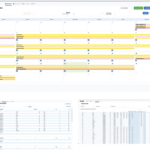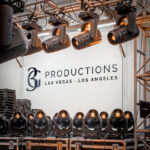That starts with their R&D process. To create the Roland Systems Group, they turned to some of Roland’s senior developers, “brilliant guys, and then we’ve put in a mix of fresh video-specific engineers.”
Today, the company’s video mixers are getting used at festivals like Coachella. Artists like Vello Virkhaus of V Squared Labs uses them for the “crazy crazy stuff” he does. “And at a place like Coachella, with 10 stages and scores of acts, you have different artists coming up all the time going ‘Here’s my hard drive, my Blu-ray, this format, that format,’ and our mixers can take any and all of those pieces and get it displayed quickly.”
» Audio to AV
 Broadhead’s background is in space and defense engineering. But when the opportunity came for the lifelong musician (keyboards and guitar) to move to Roland, he gleefully jumped ship. He came aboard in 2000, specifically to help develop new market areas, including video.
Broadhead’s background is in space and defense engineering. But when the opportunity came for the lifelong musician (keyboards and guitar) to move to Roland, he gleefully jumped ship. He came aboard in 2000, specifically to help develop new market areas, including video.He reminds us that Roland’s long been on the cutting edge of related technology, noting how, during their earlier days, when they were creating desktop music products, the company was an early adopter of USB and Firewire audio technology.
Their first U.S. video product came out in 1998 — the Roland V5 Video Canvas, a 640-by-480-resolution video processor. “You still see them out there being used,” Broadhead says, of the four channel video mixer that was typically paired with the A6, a “four track hard drive recorder/mixer that was their first foray into bringing an integrated audio/video production solution down to an affordable level.”
 » First “Home Run”
» First “Home Run”In 2002, the V5 grew into the V4, which, Broadhead says, still dominates the standard definition market today. “It’s a four channel video mixer that has lots of effects and fun features, all available at around $1,000,” he notes. “There have been well over 50,000 sold worldwide, and it’s become a staple of many artists.”
In the early days, the V4 was used by visual artist in smaller shows and clubs, and the affordability of the unit led to the proliferation of an exciting visual element in those environments. Many of those artists graduated to more advanced production requirements and brought their Roland video gear with them. Broadhead adds that the V4 was the first “home run” of the video division of Roland, which they’ve followed every year with four or five other products in various categories
“On the higher end, we have the V-1600HD, that came out a couple of years ago.” The multi-format live video switcher handles a variety of video sources such as cameras, VTR’s, RGB Computer Sources, Blu-ray/DVD, and high-end SD/HD-SDI video sources.
 That was followed by the V-800HD, which is slightly smaller in functionality and budget, but seems to hit the right balance of functionality and price for many end-users. “Churches, many which are really performance arts centers in their own right, are offering these very visually and aurally engaging services, and Roland is there for their audio and visual production desires.”
That was followed by the V-800HD, which is slightly smaller in functionality and budget, but seems to hit the right balance of functionality and price for many end-users. “Churches, many which are really performance arts centers in their own right, are offering these very visually and aurally engaging services, and Roland is there for their audio and visual production desires.”The education market is also gravitating to Roland’s video products, as they had done previously with the company’s audio gear and musical instruments, Broadhead says, noting how the V4 and newer V-4EX are helping educators “take digital input to the next level.”
Roland then “married” the audio with the visual. The VR-5 and VR-3 are “all in one” units that embody “why Roland is doing this,” Broadhead says. He adds that what is unique with these units is they feature an USB output that let users connect with a computer and use the units for recording or live streaming. “It’s a full mini-production station that allows you to take what you’re doing live directly to the web or other recording device.”
Specifically the VR-5 incorporates a video switcher, audio mixer, video playback/recorder, preview monitors and output for web streaming in a single unit. You can connect with common services such as UStream or Livestream or even video call services such as Skype and iChat. “The VR-5 is great for schools, and they are using them to do morning broadcasts, ‘news reports,’ broadcasting their school’s sporting events, and a whole hosts of other activities.”
Roland is aware that emerging artists and professionals are dealing with a variety of formats now. “With computer formats, standard and high definition, it’s a multi-format world,” he says. “There’s all these different elements in the video world that you don’t find in the audio world in terms of connectors, formats, screen sizes, pixel ratios, frame rates, encoding, etc. The video market is a lot more complex. Our switchers and converters can greatly simplify all that for you.”
The company’s video converters are increasingly being relied upon to navigate murky multi-format waters. When “you’re working on something in Europe, and broadcasting that to other parts of the world that have different frame rates and formats, one of these boxes takes care of converting almost anything to anything — and at a price point that is affordable compared to the next alternative.”
Going forward, don’t expect any half million-dollar products that only 10 companies in the world can afford to buy. “What we’ve always done at Roland Systems Group is build products that get more people involved in the creative process,” Broadhead says. “We don’t create cheap products, and we never want to race to the bottom with the lowest price. But having things be at an accessible price point allows the creative process to be a true democracy. Churches, educators, corporations, guys who work the clubs and festivals, the weekend warrior bands, they are all able to step up their gear and produce something better.”


